The Motherland of Oil Palm – a Travel Journal of West Africa
Noboru Ishikawa(Center for Southeast Asian Studies, Kyoto University)
The landscape of a myriad of oil palm trees has now become a familiar sight in Sarawak, Malaysia where we have been working on our project. Oil palm trees originate from Africa and just like rubber, oil palm has flourished as a commercial crop in insular Southeast Asia, very far from its original birth place. Today, oil palm (Elaeisguineensis) is grown in plantations, and now has considerable impacts on the local communities and ecological environment of Southeast Asia. The following outlines the thoughts that crossed my mind during my field trip to South Africa to study the origin of oil palm.
From August 12-21 of 2011, I had the opportunity to take a field trip to Guinea and Senegal with Gen Yamakoshi of the Graduate School of Asian and African Area Studies, Kyoto University (primatology, African area studies), Masayuki Yanagisawa of the Center for Integrated Area Studies, Kyoto University (agricultural ecology, Vietnamese area studies), and Masaaki Hirai of Center for African Area Studies, Kyoto University (ecological history, African area studies). The details and information of this field trip I shall put aside for another occasion. Therefore, the following outlines my thoughts on the discussions and exchange of views and opinions I had with my three colleagues who come from different academic fields.
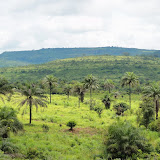
As I watched the scenery pass by from the window of my car, I noticed the ubiquity of the landscape of oil palm trees in this country. For a long time people in this land have continued swidden farming, while maintaining the presence of oil palm trees. People set fire to the fields as necessary to cultivate cassava, rice and peanut. Oil palm trees have a fireproof nature and can survive bush fires. This is the reason for the plantation-like appearance of groups of oil palms among the fields from time to time. I saw oil palm trees scattered from flat land to the top of a ridge, and the landscape seemed very strange to me as it was so different from the landscape of the oil palm plantations in Borneo. Yamakoshi said, judging from the old photos, that today’s landscape of this land is not so different from that of the colonial-era when it comes to oil palm trees. It comprises secondary forest, the landscape human intervention has created and maintained. The scenery changed as we headed south and soon oil palm trees were blending into some parts of the jungle. We paid a visit to the forest of Bossou village where the Primate Research Institute of Kyoto University has built and maintained a field station for more than 30 years to observe chimpanzees in the forest. The forest of Bossou is somewhat similar to Japanese “sacred forest” at Shinto shrines (chinjyu no mori), and it is culturally contraindicated with the local people. The jungle is surrounded by vast slash-and-burn fallowed forests where oil palm trees grow wild. Some portion of the wild oil palm trees has been spread by the chimpanzees. They eat the oil palm fruit and disperse the seeds in other areas through their excrement. However, oil palm fruit is not always the chimpanzees’ first choice for their daily food; it is nothing more than a substitute food they choose when no other fruit is available.
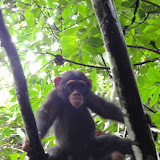
Palm oil is indispensable to the daily lives of people in West Africa. It is in constant use in their cooking because it simply adds extra flavor. The oil palm fruit of Sarawak tastes bitter and it inevitably makes us wonder how much chemical fertilizer has been used. But here, when you bite into it, oil palm fruit tastes somewhat sweetish, and its oil is quite tasty and versatile for any kind of meal. People put palm oil on their food just like extra virgin olive oil to add extra flavor. In this way oil palm is very popular among the people in West Africa as a condiment for their meals once extracted; the oil has become a stable source of income. No wonder the crop has become widely prevalent in this country.
In Guinea, oil palm is a major part of the national landscape, national income and national diet. Interestingly, in this country no one owns oil palm trees. There is a common view of the oil palm as an “ownerless property” among the people of Guinea. People share the mutual understanding of “Tu peux le prendre, si tu peux” (You can take it, if you can) regarding oil palm. There’s no ownership of trees by kindred groups as in the case of Borneo.
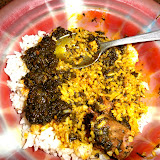
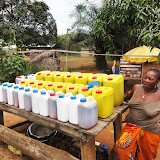
We must, however, pay close attention to the production process of palm oil and its social and human relations to understand the state of ownerless oil palm trees. Yamakoshi explains the key to understanding the ownerless state of the oil palm trees lies in the phrase, “if you can”. Using a special tool, climbing up the tall trunk of an oil palm tree, cutting down clusters with a machete, is dangerous and labor-intensive work. Ants, nesting in the trees are troublesome enough but the snakes are even worse. Extracting palm oil is grueling work; the oil palm fruit needs to be boiled over high heat for a long period of time. As a result, this extraction process requires group work that exceeds the boundaries of personal territory or family units. In this country, there are traditional gender roles for this complicated production process of palm oil. If viewed from the aspect of production, oil palm can be described as natural goods, which have a certain production process style and a unique position in society. “Si tu peux” (You can have it, if you can collect oil palm fruit and refine its oil) and once we focus on the uniqueness of oil palm, its biology and its position in society, soon we notice that “ownerless property” is a multilayered term. Most forest products we are familiar with in Borneo are on the global market today. Oil palm, lumber, rubber, coconut, engkabang, cane, jelutong, dammar, gutta percha and bird’s nest have been introduced into the markets of Europe, the Middle East and Far East. Forest resources, collected by the Penan, Kayan and Iban people have been used for a number of things: cable material for undersea cables, grenade holders used during European wartime, tanning agents for harnesses, ceremonial incense, and an exotic food for expensive restaurants. In comparison to the commercial network of non-wood forest products in Borneo, the exchange network of South African forest products is more regional. Ivory, copal and coffee are South African forest products that have been distributed worldwide but the volume seems to be less compared to that of Southeast Asia. Kola nut is widely known as it is an ingredient of Coca-Cola, but its distribution area is mainly inside Africa. Why is it that tropical African forest products have not been distributed worldwide while those of insular Southeast Asia have built tight connections with the markets overseas like Singapore or London and have become global commodities? I guess there’s no short cut to getting an answer to this question. Perhaps all I need to do is walk around both Africa and Asia.
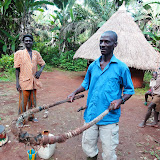
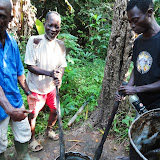
Currently, large-scale oil palm plantations are becoming the mainstream in West Africa. The oil palm prevailing in those plantations is different from traditional local oil palm, a relatively shorter and leafier hybrid that is common in Malaysia and Indonesia. An oil palm plantation that we visited in Guinea resembled the plantations we are familiar with in Malaysia. The palm oil from those plantations has a different system of production and channels of distribution to the traditional local palm oil production. The oil palm plantation in Guinea is at an early stage of development and the business scale is still smaller than that of Southeast Asia. The future of the oil palm business in this country is dependent on constructing a framework for the plantation business, the path of which both Malaysia and Indonesia have followed. Can African oil palm plantations attract cheap foreign laborers like Malaysia or can they build a new production system based on smallholders?

During this field trip in West Africa I looked at the scenery through the lens of the oil palm plantations of Sarawak which I kept in mind all the time. It provided a good opportunity to see the issue from the viewpoint of interregional comparison. The next step, I am thinking about, is to retrace the pathway of the spread of rubber to the riverine society of the Amazon. Taking a long look at the map, we notice that the Amazon is not that far away from the west coast of southern Africa. I am thinking about traveling from the African west coast to Brazil, crossing the South Atlantic Ocean, while giving thought to the slave trade era.

 Currently, large-scale oil palm plantations are becoming the mainstream in West Africa. The oil palm prevailing in those plantations is different from traditional local oil palm, a relatively shorter and leafier hybrid that is common in Malaysia and Indonesia. An oil palm plantation that we visited in Guinea resembled the plantations we are familiar with in Malaysia. The palm oil from those plantations has a different system of production and channels of distribution to the traditional local palm oil production. The oil palm plantation in Guinea is at an early stage of development and the business scale is still smaller than that of Southeast Asia. The future of the oil palm business in this country is dependent on constructing a framework for the plantation business, the path of which both Malaysia and Indonesia have followed. Can African oil palm plantations attract cheap foreign laborers like Malaysia or can they build a new production system based on smallholders?
Currently, large-scale oil palm plantations are becoming the mainstream in West Africa. The oil palm prevailing in those plantations is different from traditional local oil palm, a relatively shorter and leafier hybrid that is common in Malaysia and Indonesia. An oil palm plantation that we visited in Guinea resembled the plantations we are familiar with in Malaysia. The palm oil from those plantations has a different system of production and channels of distribution to the traditional local palm oil production. The oil palm plantation in Guinea is at an early stage of development and the business scale is still smaller than that of Southeast Asia. The future of the oil palm business in this country is dependent on constructing a framework for the plantation business, the path of which both Malaysia and Indonesia have followed. Can African oil palm plantations attract cheap foreign laborers like Malaysia or can they build a new production system based on smallholders?
 During this field trip in West Africa I looked at the scenery through the lens of the oil palm plantations of Sarawak which I kept in mind all the time. It provided a good opportunity to see the issue from the viewpoint of interregional comparison. The next step, I am thinking about, is to retrace the pathway of the spread of rubber to the riverine society of the Amazon. Taking a long look at the map, we notice that the Amazon is not that far away from the west coast of southern Africa. I am thinking about traveling from the African west coast to Brazil, crossing the South Atlantic Ocean, while giving thought to the slave trade era.
During this field trip in West Africa I looked at the scenery through the lens of the oil palm plantations of Sarawak which I kept in mind all the time. It provided a good opportunity to see the issue from the viewpoint of interregional comparison. The next step, I am thinking about, is to retrace the pathway of the spread of rubber to the riverine society of the Amazon. Taking a long look at the map, we notice that the Amazon is not that far away from the west coast of southern Africa. I am thinking about traveling from the African west coast to Brazil, crossing the South Atlantic Ocean, while giving thought to the slave trade era.
